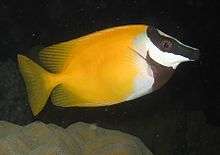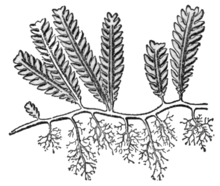Foxface rabbitfish
The foxface rabbitfish (Siganus vulpinus) is a species of fish found at reefs and lagoons in the tropical Western Pacific.[2] It belongs to the rabbitfish family (Siganidae) and is sometimes still placed in the obsolete genus Lo. Other common names are foxface or foxface lo, but these properly refer to any of the rabbitfish species once separated in Lo, e.g. the closely related[3] bicolored foxface (S. uspi). It is often seen in the marine aquarium trade.[2]
| Foxface rabbitfish | |
|---|---|
 | |
| Adult, day color | |
| Scientific classification | |
| Kingdom: | Animalia |
| Phylum: | Chordata |
| Class: | Actinopterygii |
| Order: | Perciformes |
| Family: | Siganidae |
| Genus: | Siganus |
| Species: | S. vulpinus |
| Binomial name | |
| Siganus vulpinus | |
| Synonyms | |
|
Amphacanthus vulpinus Schlegel & Müller, 1845 | |
The blotched foxface (S. unimaculatus) differs from S. vulpinus in possessing a large black spot below the aft dorsal fin. It is sympatric and not phylogenetically distinct, and though these two might be recently evolved species, they are more likely just color morphs and ought to be united under the scientific name S. vulpinus.[4]
Diet

.jpg)
Siganus vulpinus is omnivorous, eating mostly algae and zooplankton.[5] From time-to-time, if hungry, it may nip at corals, such as Zoantharia (zoanthids and button polyps). Though not an obligate herbivore, the foxface rabbitfish does require algae in its diet. In captivity, it can usually be coaxed into eating a combination of mysis shrimp, sheets of dried seaweed, and marine flake food containing algae. It is popular with aquarists due to its appetite for feather caulerpas (Caulerpa crassifolia, C. mexicana, C. sertularoides), macroalgae that commonly overgrow the rockwork in home aquaria. S. vulpinus is highly skilled at removing this alga and will generally clear an aquarium of it within a matter of days.
References
- Carpenter, K.E. & Smith-Vaniz, W.F. 2016. Siganus vulpinus (errata version published in 2017). The IUCN Red List of Threatened Species 2016: e.T69738933A115471944. https://dx.doi.org/10.2305/IUCN.UK.2016-3.RLTS.T69738933A69742649.en. Downloaded on 24 July 2020.
- FishBase (2008)
- Kuriiwa et al. (2007)
- Kuriiwa et al. (2007), FishBase (2008)
- Lougher, Tristan (2006). What Fish?: A Buyer's Guide to Marine Fish. Interpet Publishing. p. 118. ISBN 0-7641-3256-3.
Wild specimens feed primarily on algae and zooplankton.
| Wikimedia Commons has media related to Siganus vulpinus. |
- FishBase (2008): Siganus vulpinus - Foxface. Version of 2008-JAN-14. Retrieved 2008-AUG-31.
- Kuriiwa, Kaoru; Hanzawa, Naoto; Yoshino, Tetsuo; Kimura, Seishi & Nishida, Mutsumi (2007): Phylogenetic relationships and natural hybridization in rabbitfishes (Teleostei: Siganidae) inferred from mitochondrial and nuclear DNA analyses. Mol. Phylogenet. Evol. 45(1): 69–80. doi:10.1016/j.ympev.2007.04.018 (HTML abstract)
External links
- Photos of Foxface rabbitfish on Sealife Collection
